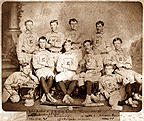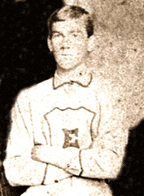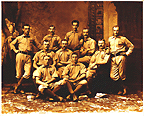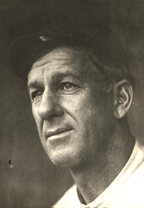
![]()
Few stars shone as brightly on the national sports scene during the 1880s as Pete Browning, known to baseball cranks as “The Gladiator” or “The Louisville Slugger.” A tremendous all-around athlete who overcame a severe hearing disorder, Pete was a .341 lifetime hitter and three-time batting champion. During his 13-year career, he encountered only one adversary he could not overcome: liquor. Cast by history as drunkard and defensive clown, Pete is among a group of great American Association stars inexplicably shunned by the Hall of Fame. Only when the truth was uncovered about his medical condition—and records of his fielding prowess unearthed—did fact replace fiction and an accurate picture of Pete begin to emerge. This JockBio Legend, by Philip Von Borries, is the result of much of that fine work.
Louis Rogers “Pete” Browning was born in Louisville, Kentucky on June 17, 1861 at 13th and Jefferson on the city’s west side. Because the state of Kentucky did not require the official recording of vital statistics until 1911, no formal birth certificate exists today for Pete or any of his seven siblings. The youngest of eight children (four boys and four girls), he was the son of Kentucky natives Samuel Browning and Mary Jane Sheppard Browning. The pair were married in Jefferson County the day after Valentine’s Day in 1849.
In October of 1874, when Pete was 13, his father died from injuries sustained during a cyclone. A prosperous merchant, the elder Browning for years had run a grocery store just a few blocks from the family’s residence. Pete’s mother, with whom the confirmed bachelor lived all his life, lasted substantially longer. She died April 6, 1911, at age 84.
As
a youth, Pete was a great athlete and avid sportsman who studiously avoided
schoolwork. Frequently, he would hide the schoolbooks his mother had provided
him under the doorsteps of the home of John Reccius. A teammate of Pete’s
on some early Louisville teams—and later a pallbearer at his funeral—Reccius
was a part of a noted Louisville baseball family that included brothers
William and Philip. Rounding up companions, Pete spent more days than
not shooting marbles, spinning tops or playing ball. On his diamond prowess,
the Courier-Journal said this in his obituary: “When a
lad, he began playing ball on the commons, and was a good player from
the start.”
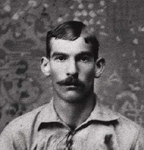 |
Pete’s proficiency as a marble shooter mirrored that of another Louisville product who made it to the major leagues, Dodger Hall-of-Fame shortstop Harold “Pee Wee” Reese. A master of the game in his neighborhood, where he regularly won all the marbles of his friends, Pete got in the habit of returning all of the agates except the prized ones, which he kept for himself. Eventually he accumulated a trunk full of them. In fact, Pete’s reputation became so great that he had to travel to the east end of Louisville, where he was unknown, in order to find a game.
According to several newspaper accounts, Pete was also a superb skater—”easily the best in Louisville”—who possessed an ability to “cut more funny figures and skate faster than any other boy of his acquaintance.” A lover of the outdoors, he enjoyed all athletics except swimming, which he claimed hurt his ears. This was hardly insignificant since Pete, a resident of a town nicknamed the “River City,” was only blocks away from the Ohio River.
Pete’s repeated absences from the classroom in lieu of sports as a young man had the expected repercussions: they left him uneducated and rendered him a functional illiterate his entire adult life.
Pete’s arrival into adulthood came early. On Friday, April 13, 1877—some two months shy of his sixteenth birthday—he made what is thought to be his debut as an organized ballplayer for the city’s nationally known semipro club, the Eclipse. It came against penthouse competition no less, the city’s charter National League club, the Louisville Grays. Picked by many to take that year’s National League flag, the powerhouse Grays were about a month away from their seasonal opener.
Behind Jimmy Devlin’s nifty three-hitter, the Grays decimated the Eclipse 22-1. As for Pete, his first official appearance was unremarkable—he went hitless in four at-bats—perhaps understandable in light of the competition (and maybe even the date, Friday the 13th). Nevertheless, it was a start all the same, and on July 28, he made his first big imprint as a ballplayer. Using a fine curveball and deceptive change of pace, Pete hurled the Eclipse to a 4-0 shutout win over the vaunted Grays. The young right-hander’s strikeout victims that day included slugging outfielder George Hall and ace hurler Devlin. Later in the season, the pair would become notable for a different reason. Both were participants in a National League pennant-fixing scandal that eventually cost the city its major-league team and resulted in the lifetime ban of four Louisville players.
By this time, Pete had acquired the two characteristics for which he would become quite well known. A childhood ear infection had rendered him deaf, or close to it. And he had already developed a taste for liquor. According to his 1905 obituary in the Louisville Times, "’Old Pete’ was never known to take a drink until he played a game in this city with an amateur nine. He was asked to fill in for one of the players. On third base, a keg of beer had been placed, and those who reached the foaming fountain were entitled to a glass of lager. Pete knocked so many three-baggers and home-runs that little beer was left for anyone else."
On the surface, the
tone was somewhat light, even humorous. Between the lines, however, lay
a bone-chilling commentary of Pete’s alcoholic abuse, which had
begun as a teenager.
Between 1877 and 1881, a period he spent principally with the Eclipse, Pete’s baseball reputation grew. Initially, he was best known for his infield play. Early in his career, he also laid the groundwork for a lifelong battle with the press. On July 2, 1881, Charles Guiteau—a disappointed office-seeker and Republican factionalist—shot newly-elected President James A. Garfield in Washington’s Baltimore & Potomac Railroad Station. Lingering for several months, Garfield finally died on September 19. Subsequently informed of Garfield's death, so the story goes, Pete queried an astonished reporter: "Oh, yeah? What league was he in?"
Later, as a major-leaguer, Pete gained the monicker of "The Gladiator"—both for his ongoing confrontations with the fourth estate and his pathological alcoholism. Perhaps he phrased it best in another memorable quote: "I can't hit the ball until I hit the bottle!" (Long incidental to Pete’s nickname were stories of his epic battle with fly balls, though the facts suggest that he was actually a skilled defensive player.)
Pete, who stood six feet and weighed 180 pounds, was unquestionably eccentric. Even today he rates as one of the game’s most colorful characters. In Pete's Louisville Times obituary, Reccius recounted an oddity of the Gladiator’s playing style: “Pete was afraid of players coming in on the bases. He had a habit, too, of standing on one foot and extending the other knee if he saw a fielder approaching him... He always declared that if the man ran into the bone (the knee), he would be put out of business and ‘Old Pete’ would escape injury... After Pete went to the outfield, he would often catch a ball standing on one leg, with the other knee extended. Browning was also timid at the bat when the speedy pitchers were putting them in close.”
Pete’s peculiarities on defense were partially explained in the Courier-Journal obituary. “He was one of the best infielders who ever played on Louisville, but he lost his nerve after being run over and spiked by players on several occasions and was shifted to the outfield, where he always played after that time.” The fear of being spiked also presumably was behind his well-known refusal to slide.
The Times obituary provided another rich tidbit on Pete: “Old Pete enjoyed notoriety. When traveling over the circuit, the Gladiator would frequently alight from the train and exhibit himself to people at the station, and if no one recognized him, he would introduce himself as the champion batter of the American Association. He has been known to impart his identity to a lone station agent.”
The complete package
as a legend, Pete also stared into the sun to improve his “lamps”
(eyes), treasured his “active” bats because of the hits they
still contained, was constantly on the prowl for a new “magical”
stick with hits in it, maintained a warehouse of “retired”
bats—many of them named after Biblical figures—in his home,
and kept his batting statistics on his shirt cuffs.
In 1882, Louisville went major-league again, this time as a charter member of the fabled American Association, the National League’s first great rival. His skills honed to a fine edge, Pete, already a hometown hero, notched his first two hits (a single and a triple) in his second contest, May 3 at St. Louis.
Though such games are not part of the official records, an exhibition contest against a strong Atlantic City team on May 27, 1882 is noteworthy for several reasons. In the 10-7 Eclipse win, Pete launched a gigantic home run. According to the game account, he drove “the ball over the center field fence, almost on a dead line, for a home run.” No mean feat for the deadball era, when an inside-the-park “en circuit” was the norm. The mammoth home run was no optical illusion, but an accurate reflection of Pete’s prodigious power. Of it, he modestly said: “It was the longest hit I ever made, an all-around-the-world hit, and it’s still going yet.”
The game is also instructive of the times, when regular-season exhibition games between big-top teams and semi-pro clubs were as much a matter of course as were pre-season, intra-season and post-season games between National League and American Association clubs.
The close of the season also produced one of Pete’s signature games. In a September 12 contest at Cincinnati that was sandwiched between no-hitters by Tony Mullane and Guy Hecker, he unloaded for a pair of home runs and a triple in the 10-4 Eclipse win. By this point in ‘82, Pete had run away with the American Association’s inaugural batting race. His .378 average was 36 points better than that of his nearest AA rival, Cincinnati’s Hick Carpenter. Moreover, it was the best in the majors, topping Dan Brouthers’s National League titlework by 10 points.
Pete played second, third and short during the year, his last as a full-time infielder. The Eclipse finished third behind the Cincinnati Red Stockings and Philadelphia Athletics. Louisville’s primary starter, Mullane, won 30 games and lost 24. The team’s second-line starters were Hecker, who doubled as the everyday first baseman, and Reccius, who roamed the outfield and had a knack for working walks.
Pete’s monster rookie season also included the American Association’s slugging-average (.510) and on-base-percentage (.430) championships. In addition, he ranked second in hits (109), fourth in total bases (147) and runs scored (67), and was among the league leaders in home runs and walks. All told, it was one of the finest rookie seasons ever in the game’s history. And more destruction was on the way from the 21-year-old star, still a few years away from his prime.
With Major League
stardom came a drinking problem that didn’t take long to reach major-league
proportions. In an August 13, 1882 contest against the Athletics, Pete
was so drunk the Louisville Courier-Journal wrote a scathing
story the next day. (His inebriated state notwithstanding, he collected
two hits in four at-bats in a 7-4 win .) The Eclipse barely reacted to
the bad press. They did not release their star, nor did they tighten the
rope any.
The reasons for the Eclipse’s lack of disciplinary action were obvious. The fabulous homegrown rookie had brought Louisville back to major-league baseball with a flourish—he was tearing the league apart with his stick and was clearly a foundation franchise player, one who could give relief to the common man everywhere from his daily oppression. Without Pete, Louisville would have quickly found itself playing to an empty ballpark. And, everyone knew it: the press, the Eclipse's incompetent management, his teammates (many of whom were jealous of his stardom), and most of all Pete’s loyal fans.
Though no one will ever know for sure, it seems safe to say that Pete’s alcoholic display was the result of a lifelong mastoiditis condition, a bacterial infection of the skull’s mastoid bone. Frequently, it is a complication of acute otitis media, or a middle ear infection. The infection spreads from the ear to the mastoid bone, which is located just behind the ears and connected to the temporal bones that run along both sides of the head.
The mastoid bones (also known as the mastoid process) are two honeycomb-like areas that occasionally aid the human ear by acting as a surplus receiving area for violent sound vibrations—such as a sudden, nearby explosion—that the ear cannot handle by itself. Unchecked or crudely treated, mastoiditis can cause the mastoid bone to deteriorate. Once a leading cause of death in children, mastoiditis is now treated with antibiotics. In Pete’s case, the condition robbed him of his hearing when he was young, turning him into what today would be called a functional illiterate.
By his early 20s, if not earlier, Pete appears to have been a liberal self-medicator, and hardly attempted to hide it. Certainly, the two pathologies followed him, always interlocked, his entire life. Wherever the mastoiditis went, the bottle was not far behind.
Unlike many major leaguers, Pete cut a swath through the sophomore jinx in 1883, batting .338 and finishing second to Pittsburgh’s Ed Swartwood for league honors. Close examination of the boxscores from that fine follow-up campaign correct two long-standing statistical errors about Pete. Official baseball records credit him with hitting for the cycle a record-tying three times in his career, including a May 2, 1883 game against Columbus. Though he did get four hits in the 13-6 Louisville victory, Pete—horribly sick—actually singled three times and doubled once.
The other error has
to do with when Pete was first hit by a pitch. Prevailing legend says
that he played for nine years before being plunked (in the back on May
8, 1890). The first documented instance, however, was a July 8, 1883 contest
when he was struck on the leg and forced to leave the game.
Pete split his time between the infield and outfield in 1883, and the Eclipse finished in fifth place with a respectable 52-45 record. Mullane had moved on to the St. Louis Browns, leaving Hecker to divide pitching duties with Sam Weaver. Each won 26 games, but Pete got little support on offense, leaving the Eclipse hovering just above .500.
The 1884 campaign was a busy season as major-league baseball had no less than three circuits from which the fans could choose. The newcomer was the Union Association, which lasted but a year. The season also witnessed the first sanctioned World Series, the National League champion Providence Grays besting the American Association titlist, the New York Mets. And on May 1, Moses Fleetwood Walker, the game’s first black major-leaguer, made his debut in Louisville against the Eclipse. Walker caught for the Toledo Blue Stockings and took an oh-fer. Two days later he collected his first hit.
In retrospect, Louisville was something of a mecca for black American sporting history that year. Across town, Isaac Murphy—America’s first great black athlete—notched his first Kentucky Derby win, aboard Buchanan. Ironically, the stewards had to force the jockey to ride the fractious colt. By the time Murphy hung it all up, he had become the first rider to take three Kentucky Derbies and the first to pilot consecutive Derby victors (Riley in 1890 and Kingman in 1891). A charter member of the Racing Hall of Fame, Murphy today is considered by many to be the greatest jockey ever.
Hours after Walker got his first major-league hit, Pete used his athletic ability in a most heroic way—off the baseball field. The following morning’s Courier-Journal reported on the event: “Browning saved a boy from being run over by a street-car at Seventeenth and Marinet last night. The little fellow was trying to cross the track, when the mules struck him and knocked him under the car. Browning was standing by, and pulled him out in time to save his life." (Interestingly, this majestic story is not a part of the Browning myth, perhaps because it is true and can be documented.)
In the spring of 1884, another legend was born when John Andrew “Bud” Hillerich custom-made a bat for Pete, who was in the midst of a bad slump. The Gladiator went out the next day and got three hits. As they say, the rest is history. The incident forged modern batmaking, ultimately leading to the birth of two American icons—the world-famous Louisville Slugger bat and its equally-renowned creator, Hillerich & Bradsby.
In recent years, this story has come under inspection, because no reference to it has ever been found in that season’s baseball coverage or in Pete’s obituaries. At the time of this writing, in fact, there are three other versions. One reports that the first Louisville Slugger bat was made for Walter Arlington “Arlie” Latham (who was also known as “The Freshest Man On Earth” because of his cocky personality, vile bench-jockeying talents and his vulgar mouth). In a 1937 article, Latham claimed that he was the first recipient of a Louisville Slugger, in either 1883 or 1884. According to him, he visited the Hillerich wood-turning shop near his hotel after breaking his lumber in a game. There, Hillerich agreed to make him a bat for the next day’s contest.
That account was backed
up by a 1942 letter from Hillerich himself. However, that missive was
more likely the product of diplomacy than anything else, since Pete had
been long dead, and Latham was still very much alive. In addition, it’s
highly unlikely that the first Louisville Slugger bat would have been
made for a player who never spent a day in a Louisville uniform—a
lifetime .269 hitter to boot—when that city had a demi-god hitting
legend available from exactly the same timeframe in the form of Pete.
The ego-driven Latham story has the least credibility of the four Louisville Slugger tales. (Further confusing the Latham story is an A.H. Tarvin article that says Latham was one of many players who followed Pete’s example after they saw The Gladiator ‘s success with the bat.)
Another Louisville Slugger account says that Hillerich, a fine player as a youngster, either lost or had his “turned” (custom-made) bat stolen while a member of the Morning Star team in 1883. Recovered in time for the 1884 season, it then fell into the hands of Gus Weyhing, a minor-leaguer who would go on to win 264 games during his big-top career. Weyhing reportedly passed the bat along to several Louisville players. In due course, its reputation as a quality stick—first called Hillerich bats, then Falls City Sluggers and finally Louisville Sluggers—led to the establishment of the Hillerich & Bradsby Company. The expanded commercial production and distribution of this signature item followed some time later.
Yet another elaborate yarn appears in Ira Smith’s 1954 book, Baseball’s Famous Outfielders. Though it contains some tempting kernels of truth, this story—which has Pete asking Hillerich & Bradsby to reproduce a favorite bat shattered that afternoon—does not check out.
As a result of these contradictory tales, Pete’s longstanding historical link with the Louisville Slugger bat is assumed to be tenuous at the very least, non-existent at the very worst. That is predicated upon the belief that the 1884 episode is his only link with Hillerich & Bradsby.
Missed in this rush to judgment (again a product of the errors that have plagued Pete’s life and career), is the true nature of the beast: that the “first” Louisville Slugger is one of those rare historical incidents in which the inaugural event cannot be traced directly to the namesake. (This, it seems, is something that could only happen to Pete.)
Nevertheless, the tie between Pete and the Louisville Slugger bat remains sound in several arenas. Indeed, their connection is so strong that it has reached metaphysical and literary proportions. To date, Pete has been the subject of two finely-crafted pieces of historical fiction: David Nemec’s Browning’s Lamps and Jo Ann O’Connor’s The Birth Of The Bat.
Further support of Pete’s link to Louisville Slugger is seen in the trademark of the name in 1894. When the Hillerich & Bradsby Company (then called the J.F. Hillerich Company) registered “Louisville Slugger,” the company had one person and one person only in mind: Pete Browning. Unlike the native birth of the bat, its namesake had a precise genesis. Newspaper coverage of the period repeatedly identified Pete as the “Louisville Slugger.” One example is a June 17, 1891 Louisville Post headline that referred to him as such.
Though his best-known nicknames were “Pete” and “The Gladiator,” he also had a third monicker, for some reason lost in the mix: The Louisville Slugger. It is not by accident that Pete’s last season was the Louisville Slugger bat’s first under that name, kind of a going-away present for the aging star. In the end, his shelf life as the Louisville Slugger namesake player—and inspirational spirit—is infinite, unlimited, and undeniable.


